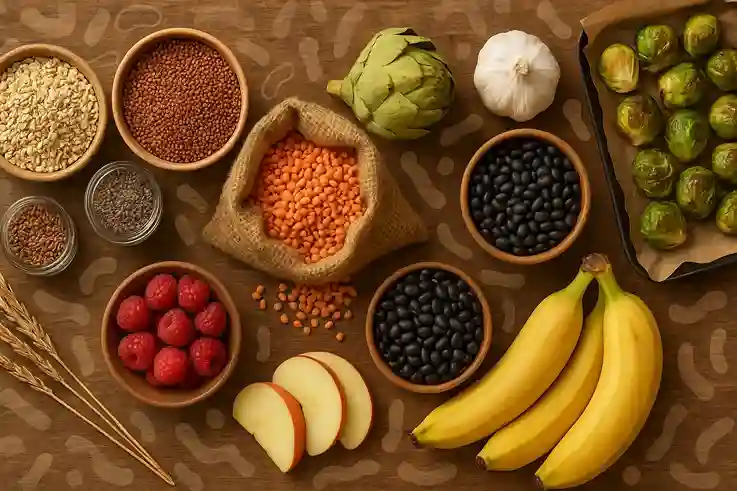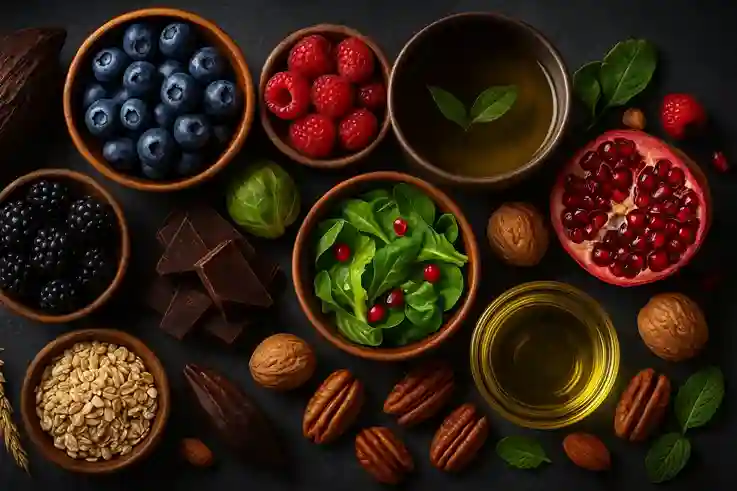Foods for Gut Health: Science-Backed Ways to Feel Better
Science confirms that foods for gut health like yogurt, sauerkraut, and beans—can reduce bloating, boost immunity, and even sharpen your mind.
A few years ago, I struggled with constant fatigue and bloating. After a gastroenterologist told me my gut bacteria were out of balance, I dove into research—and the results shocked me. Within weeks of eating more fermented and fiber-rich foods, my energy and digestion improved dramatically.
Why does this matter so much? Because your gut health impacts far more than just digestion. Research published in Nature shows the gut-brain axis directly influences mental health, while other studies link a healthy microbiome to stronger immunity and better nutrient absorption. In fact, about 70% of your immune system resides in your gut.
The foods you eat directly determine which bacteria thrive in your digestive system. Feed the good ones, and they’ll return the favor with better digestion, clearer skin, and even improved mood. Get it wrong, and you might experience bloating, fatigue, or frequent sickness.
This isn’t just theory—it’s biology you can taste. Those tangy fermented foods? They’re packed with probiotics. The fiber in your morning oats? It’s fuel for your gut’s good bacteria. Even dark chocolate (yes, really!) contains polyphenols that support microbial diversity.
In this guide, we’ll explore the science-backed foods that transformed my gut health and how you can incorporate them into your daily meals. Because when your gut is happy, your entire body feels the difference.
Gut Health 101: Why Your Microbiome Matters

Your Gut’s Microscopic Metropolis
Your digestive tract hosts an astonishing 40 trillion microorganisms, according to NIH research (2023). This thriving microbial community includes both beneficial bacteria that support your health and harmful strains that can cause problems when overpopulated.
The Power of Microbial Balance
When your gut microbiome maintains the right balance, you experience smoother digestion, more stable energy levels, and stronger immune function. This equilibrium helps regulate everything from nutrient absorption to inflammatory responses throughout your body. (Cell Host & Microbe, 2021).
Recognizing an Unhappy Gut
Common signs of microbiome imbalance include persistent bloating after meals, unexplained fatigue that lingers throughout the day, frequent illnesses that suggest immune system struggles, and sudden skin irritations like acne or eczema flare-ups. Many people don’t realize these seemingly unrelated issues often trace back to gut health.
The Gut-Brain Connection
Groundbreaking research reveals your digestive system and brain maintain constant communication through the gut-brain axis. This bidirectional pathway explains why stress can trigger digestive upset and why gut imbalances may contribute to mood disorders, as noted in Nature Reviews Gastroenterology (2022).
Rapid Response to Dietary Changes
Unlike fixed genetic factors, your microbiome responds quickly to dietary adjustments. A landmark Cell study (2021) demonstrated measurable changes in gut bacteria composition within just 24 hours of altering food intake, proving you can start reshaping your microbial community with your very next meal.
Top Science-Backed Foods for Gut Health

Fermented Foods: Your Probiotic Powerhouses
For thousands of years, cultures around the world have harnessed the power of fermentation to preserve and enhance their foods. From Korean kimchi to German sauerkraut, these traditional foods were valued not just for their shelf stability, but for their remarkable ability to promote digestion and overall wellbeing. Modern science now confirms this ancestral knowledge, revealing how the biochemical transformations during fermentation create nutritionally superior foods that actively support gut health.
The Microbial Transformation Process
Fermentation represents a remarkable symbiotic relationship between humans and microorganisms. When beneficial bacteria and yeasts, often naturally present on food surfaces, begin breaking down carbohydrates and proteins, they create a cascade of biochemical changes. These microorganisms produce lactic acid, acetic acid, and other compounds that simultaneously preserve the food while generating health-promoting metabolites. The process essentially predigests nutrients, making them more bioavailable while creating new beneficial compounds not present in the original ingredients.
Clinical Research Findings
Recent clinical studies have quantified the profound impact of fermented foods on gut health. One particularly revealing 10-week intervention study tracked participants who incorporated fermented foods into their daily diets. Using advanced genomic sequencing techniques, researchers documented significant increases in microbial diversity, with new beneficial bacterial strains appearing that weren’t previously detected. The study also measured notable reductions in inflammatory markers and improvements in gut barrier function, demonstrating that these foods influence systemic health beyond just digestion.
The Spectrum of Fermented Foods
Different categories of fermented foods contribute distinct microbial profiles to the gut ecosystem. Dairy-based ferments like yogurt and kefir introduce particular strains of Lactobacillus that thrive in milk environments. Vegetable ferments such as kimchi and sauerkraut cultivate different microbial communities dominated by Leuconostoc species. Soy ferments including miso and tempeh provide yet another spectrum of microorganisms. This microbial variety is crucial because it helps create a more adaptable and resilient gut microbiome capable of maintaining balance under various dietary and environmental conditions.
Optimal Consumption Patterns
Research suggests the benefits of fermented foods follow a dose-response relationship, but with some important nuances. Regular, moderate consumption appears more effective than occasional large servings. The most effective approach involves consistent daily intake of varied fermented foods. This pattern allows beneficial microbes to establish stable populations in the gut rather than experiencing the boom-and-bust cycle that comes with sporadic consumption. Most studies showing significant benefits used protocols of one to two servings per day over several weeks.
The Holistic Value Beyond Probiotics
While much attention focuses on the probiotic aspect of fermented foods, their benefits extend far beyond just introducing live microbes. The fermentation process fundamentally alters the nutritional profile of foods in multiple ways. It breaks down hard-to-digest compounds like phytic acid that can interfere with mineral absorption. The process generates new bioactive peptides with various health benefits and increases the availability of certain vitamins and antioxidants. These comprehensive transformations make traditionally fermented foods nutritionally unique compared to both their unfermented counterparts and probiotic supplements.
Examples of Fermented Foods for Gut Health
1. Dairy-Based Fermented Foods
Yogurt – Made by fermenting milk with live cultures of Lactobacillus bulgaricus and Streptococcus thermophilus. Look for “live active cultures” on labels for maximum probiotic benefits.
Kefir – A tangy, drinkable fermented milk product containing up to 30 different strains of bacteria and yeast, making it one of the most potent probiotic foods.
2. Vegetable Ferments
Sauerkraut – Finely shredded cabbage fermented with salt, producing Leuconostoc and Lactobacillus strains. Unpasteurized versions retain live probiotics.
Kimchi – A spicy Korean staple made from napa cabbage, radish, and seasonings, fermented with Lactobacillus kimchii and other bacteria.
Pickles (Fermented, Not Vinegar-Based) – Cucumbers naturally fermented in salt brine (not vinegar) develop beneficial microbes.
3. Soy-Based Fermented Foods
Miso – A Japanese paste made from fermented soybeans (sometimes with rice or barley), rich in Aspergillus oryzae and probiotics.
Tempeh – A fermented soybean cake originating from Indonesia, bound together by Rhizopus mold, which enhances digestibility and protein absorption.
Natto – A Japanese dish of fermented soybeans with Bacillus subtilis, known for producing the enzyme nattokinase, which supports circulation.
4. Grain and Legume Ferments
Sourdough Bread – Naturally leavened with wild yeast and Lactobacillus cultures, though baking reduces live probiotics.
Fermented Lentils & Dosas – Traditional Indian dishes where lentils and rice are fermented before cooking, improving digestibility.
5. Beverages
Kombucha – A fizzy, fermented tea made with a SCOBY (Symbiotic Culture of Bacteria and Yeast), producing acetic acid and probiotics.
Kvass – A traditional Eastern European drink made from fermented rye bread or beets, containing Lactobacillus strains.
6. Condiments & Others
Fish Sauce & Fermented Shrimp Paste – Used in Southeast Asian cuisine, these protein-rich ferments develop unique umami flavors and bioactive peptides.
Apple Cider Vinegar (With the “Mother”) – Contains beneficial acetic acid bacteria, though it’s not a significant source of live probiotics.
High-Fiber Foods: Nature’s Prebiotics for Gut Health

Dietary fiber—the indigestible part of plant foods—serves as the primary fuel source for beneficial gut bacteria, making it one of the most important foods for gut health. When these microbes ferment fiber, they produce short-chain fatty acids (SCFAs) like butyrate, acetate, and propionate. These powerful compounds strengthen the gut lining, reduce inflammation throughout the body, and help regulate immune function. Research published in Gut journal revealed that people who consumed at least 30 grams of fiber daily had a 30% lower risk of developing IBS compared to those on low-fiber diets, highlighting how foods for gut health can significantly impact digestive wellness.
Top Fiber-Rich Foods for Gut Health
Several categories of foods for gut health stand out for their exceptional fiber content. Whole grains like oats and barley provide beta-glucan and resistant starch that specifically feed Bifidobacterium populations. Fruits such as apples and berries offer pectin and other fibers that enhance butyrate production. Legumes including lentils and chickpeas deliver substantial fiber while promoting anti-inflammatory gut bacteria. Seeds like flax and chia form gel-like substances that support gradual nutrient absorption. Vegetables, particularly Jerusalem artichokes and alliums like garlic, contain specialized fibers that selectively nourish beneficial microbes. These diverse foods for gut health work synergistically to create an optimal environment for microbial balance.
Scientific Support for Fiber’s Benefits
Multiple studies confirm the advantages of including fiber-rich foods for gut health in one’s diet. Clinical trials demonstrate that high-fiber diets can increase microbial diversity by 15% within just four weeks. The fermentation of these foods for gut health produces SCFAs that may lower colon cancer risk by up to 40%. Observational research has found that each 10-gram increase in daily fiber intake correlates with a 7% reduction in cardiovascular mortality. These findings underscore why prioritizing foods for gut health should be a cornerstone of any wellness-focused eating plan.
Incorporating Fiber for Optimal Gut Health
To maximize the benefits of foods for gut health while minimizing discomfort, experts recommend gradually increasing fiber intake. Begin with small additions, such as half a cup of oats or one apple daily, then slowly incorporate more fiber-rich options. Proper preparation methods, like soaking beans overnight and cooking vegetables, can enhance the digestibility of these foods for gut health. Staying well-hydrated is equally crucial, with recommendations suggesting one glass of water per five grams of fiber consumed. Those with sensitive digestion may initially tolerate cooked vegetables better than raw varieties when introducing more foods for gut health to their diet.
Balanced Approach to Gut Health Nutrition
Creating a sustainable plan for consuming foods for gut health involves both variety and moderation. A sample day might include oats with chia seeds for breakfast, lentil soup at lunch, an apple snack, and roasted vegetables with quinoa for dinner – collectively providing about 30 grams of fiber from diverse foods for gut health. This approach ensures comprehensive nutritional support for the microbiome while minimizing potential digestive discomfort that can accompany rapid dietary changes.
Tailoring Your Gut Health Strategy
Individual needs for foods for gut health may vary based on specific health conditions and tolerances. Those managing digestive disorders might benefit from focusing on low-FODMAP fiber sources initially. Others may want to explore combining different categories of foods for gut health to achieve optimal microbial diversity. Consulting with a nutrition professional can help personalize recommendations for incorporating these important foods for gut health into your unique dietary pattern.
Fiber Content in Foods for Gut Health
| Category | Food | Serving Size | Fiber (g) | Key Prebiotic/Benefit |
|---|---|---|---|---|
| Whole Grains | Oats (rolled) | ½ cup dry | 4 | Beta-glucan (boosts Bifidobacterium) |
| Barley (pearled) | ½ cup cooked | 3 | Resistant starch (feeds butyrate producers) | |
| Quinoa | ½ cup cooked | 2.5 | Balanced soluble/insoluble fiber | |
| Legumes | Lentils | ½ cup cooked | 7.5 | Promotes Faecalibacterium prausnitzii |
| Chickpeas | ½ cup cooked | 6 | Galacto-oligosaccharides (GOS) | |
| Black Beans | ½ cup cooked | 7.5 | Enhances microbial diversity | |
| Fruits | Apple (with skin) | 1 medium | 4.5 | Pectin (increases butyrate) |
| Raspberries | ½ cup | 4 | High in polyphenols + fiber | |
| Banana (slightly green) | 1 medium | 3 | Resistant starch (prebiotic effect) | |
| Vegetables | Brussels Sprouts | ½ cup cooked | 2 | Supports Akkermansia muciniphila |
| Jerusalem Artichoke | ½ cup cooked | 5 | Inulin (top prebiotic fiber) | |
| Garlic | 3 cloves | 1 | Fructans (fuel Lactobacillus) | |
| Seeds/Nuts | Chia Seeds | 1 tbsp | 5 | Forms gel to slow digestion |
| Flaxseeds (ground) | 1 tbsp | 2 | Mucilage fiber (soothes gut lining) | |
| Almonds | ¼ cup | 4 | Combines fiber with healthy fats |
Polyphenol-Rich Foods: Super fuel for Your Gut Microbiome

Polyphenols, the vibrant plant compounds in colorful foods, act as superfuel for your gut microbiome. Research shows these compounds survive digestion to reach your colon, where gut bacteria transform them into beneficial metabolites (Frontiers in Nutrition, 2021).
Regular consumption of polyphenol-rich foods creates measurable improvements in gut health. Studies document 20-30% increases in microbial diversity, with particular benefits for Akkermansia muciniphila – a key bacteria linked to metabolic health. These compounds also help control harmful bacteria like Clostridium perfringens while promoting anti-inflammatory activity.
The magic happens when gut microbes metabolize polyphenols, producing postbiotics that strengthen the gut barrier and reduce inflammation. Different polyphenols support specific bacterial strains, explaining why variety matters. For example, berries boost Bifidobacterium, while green tea catechins enhance Bacteroides populations.
This science explains why diets rich in colorful plant foods consistently correlate with better digestive function and overall health. The polyphenol-microbiome interaction represents one of nature’s most sophisticated partnerships for wellbeing.
Top Polyphenol-Rich Foods for Gut Health
| Food Category | Key Examples | Active Polyphenols | Gut Health Benefits | Research Backing |
|---|---|---|---|---|
| Berries | Blackberries, Blueberries, Raspberries | Anthocyanins, Ellagitannins | Increases Bifidobacterium; Reduces inflammation | Journal of Nutritional Biochemistry (2022) |
| Dark Chocolate & Cocoa (70%+) | Cocoa powder, Dark chocolate | Flavanols | Boosts Lactobacillus; Enhances butyrate production | American Journal of Clinical Nutrition (2023) |
| Green Tea | Matcha, Sencha | Catechins (EGCG) | Inhibits pathogens; Promotes Bacteroidetes | Nutrients (2023) |
| Olives & EVOO | Extra virgin olive oil, Kalamata olives | Oleuropein, Hydroxytyrosol | Strengthens gut barrier; Supports anti-inflammatory microbes | Multiple clinical studies |
| Nuts | Walnuts, Pecans | Ellagitannins, Flavonoids | Increases butyrate production by 30% | Human clinical trials |
Bone Broth & Healing Foods for Gut Repair

Bone broth contains key compounds like glycine, proline, and glutamine—amino acids that play a crucial role in repairing the intestinal lining. A Journal of Nutrition (2020) study found that glycine helps strengthen tight junctions in the gut barrier, reducing permeability (“leaky gut”). Additionally, the collagen in bone broth provides structural support to the gut mucosa, while minerals like calcium and magnesium support digestive enzyme function.
Key Benefits of Bone Broth for Gut Health
The intestinal lining undergoes constant renewal, requiring specific amino acids for proper regeneration. Bone broth provides glycine, proline, and hydroxyproline—structural components of collagen that directly support mucosal repair.
Glycine
It stimulates tight junction protein production, reducing intestinal permeability (“leaky gut”). A 2020 Journal of Nutrition study found glycine supplementation improved gut barrier function in subjects with metabolic disorders by 23% compared to placebo.
Collagen Types I & III
(abundant in bone broth) provide the scaffolding for epithelial cell regeneration. Research in Gut Microbes (2021) shows collagen peptides increase mucin secretion, enhancing the protective gut lining.
Glutamine
(present in smaller amounts) fuels enterocytes, the cells lining the intestines. While bone broth isn’t the highest glutamine source, its synergistic amino acid profile supports healing.
Anti-Inflammatory Effects: Calming the Gut Ecosystem
Chronic gut inflammation often stems from dysbiosis or food sensitivities. Bone broth contains multiple anti-inflammatory compounds:
- Glycine modulates inflammatory cytokines like TNF-alpha and IL-6 (Nutrients, 2021).
- Chondroitin sulfate (from cartilage) may reduce intestinal inflammation linked to IBD (Journal of Agricultural and Food Chemistry, 2023).
- Minerals like calcium and magnesium help regulate immune responses in gut-associated lymphoid tissue (GALT).
Digestive Support: Gelatin’s Role in Optimal Function
The gelatin in bone broth (collagen’s cooked form) aids digestion through multiple mechanisms:
- Stomach Acid Balance: Gelatin binds to hydrochloric acid, helping maintain optimal pH for protein digestion. Those with low stomach acid often find bone broth reduces bloating after meals.
- Nutrient Absorption: Its amino acids (especially proline) enhance the gut’s ability to absorb nutrients like zinc and magnesium, critical for enzyme production.
- Gut Motility: Glycine stimulates bile acid secretion, supporting fat digestion and preventing sluggish bowel movements.
Foods to Avoid for Optimal Gut Health
| Category | Examples | Why They Harm Gut Health | Healthier Alternatives |
|---|---|---|---|
| Processed Sugars | Soda, candy, pastries | Feed harmful bacteria; Increase intestinal permeability (Cell, 2022) | Fresh fruit, dark chocolate (85%+) |
| Artificial Sweeteners | Aspartame, sucralose | Reduce beneficial Lactobacillus; May cause glucose intolerance (Nature, 2023) | Stevia, monk fruit (in moderation) |
| Industrial Seed Oils | Soybean, canola oil | High in omega-6 fats that promote gut inflammation (Nutrients, 2023) | Extra virgin olive oil, avocado oil |
| Processed Meats | Hot dogs, deli meats | Contain nitrates linked to gut dysbiosis (Gut Microbes, 2021) | Grass-fed meats, wild-caught fish |
| Refined Grains | White bread, white pasta | Lack fiber; Spike blood sugar (harms gut lining) (BMJ, 2022) | Sprouted grain bread, quinoa |
| Alcohol (Excess) | >1 drink/day (women), >2 (men) | Damages gut barrier; Reduces microbial diversity (Gastroenterology, 2023) | Kombucha, herbal tea |
| Emulsifiers | Polysorbate 80, carrageenan | Increase bacterial translocation (“leaky gut”) (Nature, 2022) | Whole, unprocessed foods |
Occasional treats are fine, but daily consumption of these foods increases gut damage risk.
Frequently Asked Questions About Foods for Gut Health
Final Thoughts
The foods you eat directly shape your gut microbiome—a complex ecosystem that influences everything from digestion and immunity to mood and metabolism. By prioritizing fermented foods, fiber-rich plants, polyphenol-packed ingredients, and gut-healing broths, you actively cultivate a thriving internal environment that supports whole-body wellness.
Science confirms that dietary changes can rewire your gut health in weeks, with compounding benefits over time. Whether you’re seeking relief from bloating, stronger immunity, or more stable energy, the solution begins on your plate.
What’s your go-to gut-friendly food? Have you noticed a difference after changing your diet? Let’s discuss in the comments!

Amber Hexshot is a creative blogger with a specialty in home décor, where she shares fresh ideas on design, styling, and creating inviting spaces. With a keen eye for detail and a love for transforming everyday rooms into inspiring environments, she enjoys helping readers bring beauty and personality into their homes. Beyond décor, Amber also explores other topics such as lifestyle, travel, and personal growth, offering a wide variety of content that resonates with her audience.
When she’s not writing, Amber loves visiting art galleries, experimenting with DIY projects, and discovering unique design trends from around the world. Her approachable tone and practical advice make her blogs both inspiring and easy to follow.


